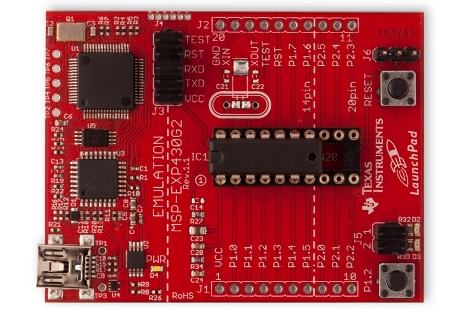
This morning Texas Instruments unveiled Launchpad, a development platform for their low-cost MSP430 line of microcontrollers. We’ve seen these chips before, most notably in the ez430 Chronos sports watch. We see this as a bid for the hobby market currently enjoyed by Arduino, PIC, AVR, and others. TI’s biggest selling point is price, but we’re going to wait to share that with you. Join us after the break to see what the package offers, then decide if the price is right.
What is it?
We received a contact request on our tip line from a public relations firm on behalf of Texas Instruments. The video conference paired us with one of their engineers who took us through the details of the package, mentioning the low price tag every minute or so. Launchpad is a programming and development board for the TI MSP430. It has a machined DIP socket that can accept chips with up to 20 pins. All of these pins are broken out to the header ports on either side of the board, which resemble the Arduino layout to us. Good news, unlike the Arduino the header spacing falls into the 0.1″ divisions necessary to interface with common*protoboard. TI is also looking for community involvement, pushing thier Lunchapad Wiki to help you get stated and asking that you add you knowledge as you find success with the 16-bit platform.
What’s inside?
Each Launchpad device comes with a whole lot of goodness. In addition to the board itself you get a 0.5 meter USB cable, two pin headers and two pin sockets for the pin breakout pads, two different MSP430 microprocessors (MSP430G2211 and MSP430G2231), and two free IDEs; Code Composer Studio 4 and IAR Embedded Workbench Kickstart (note that the latter has a 4K or 8K code limitation depending on the processor used).
Price
Hands down TI is trying to make price the biggest issue with this release. The presentation we were given included the price in large red numbers on seven of the thirteen slides. So here it is: Launchpad will set you back four dollars and thirty cents. And for now shipping is included.
Conclusion
It’s important to note that we haven’t had the board in hand yet. That being said, for $4.30 it’s worth the risk just to get the USB cable and a couple of processors. We’re amazed that they’ve beaten back the price to this point and delighted that you get the programmer and two*microcontrollers, not to mention the other components. We like the fact that they didn’t develop an alternative language like Arduino did for the AVR controllers. This makes it easy to clear the hurdle of setting up a programmer, IDE and toolchain, and get right down to developing in C. After all, the chips are dirt cheap and quite powerful. You may remember 3000 of them from a project we saw over the weekend.
We’d imagine the initial demand will be quite high and hope they have the stock to keep up.
Update:
Unboxing Video
Demo Application Video



